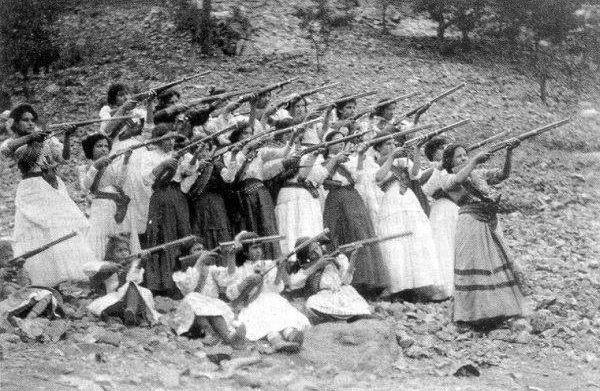Petra Herrera Wanted To Be a General
I’ve continued to stumble across stories of women warriors in the year since I turned in the manuscript (1) for Women Warriors. Sometimes people walk up to me after a book event and ask “Have you heard about [fill in the blank]?“ (2) It’s humbling how often the answer is no. The other question people ask me right now is whether I’m going to write a second volume of Women Warriors. That’s humbling in a different way. But the answer is still no.(3)
The combined affect of all this is good for any of you Marginalia who like to read about women warriors: blog post topics as far as the mind can see!
Which brings me to Petra Herrara, who fought in the Mexican Revolution of 1910. (Here’s the short version of the war: Times were hard and corrupt president Porofirio Diaz had been in office for a long time under less than democratic terms. When he announced that he would “run” for his seventh term as president, people who were hungry and frustrated rose up to overthrow Diaz and make Mexican democracy a reality. The civil war last ten years and cost 1.5 million people their lives, including Herrera)
Mexico had a long tradition of women who traveled with its armies, known as soldaderas. Most of them were the functional equivalent of the “women on the ration” common in European armies from the early modern period through the late eighteenth centuries. While their primary function was to grind the corn that provided the army’s main food staple, they could and did pick up rifles and join their male comrades in battle.
Herrera did not want to grind corn, cook or do laundry. Instead she disguised herself as a man and enlisted in the forces of Pancho Villa, who was notorious for not wanting women in his army, for all the usual reasons. Fighting under the name “Pedro Herrera,”(4) she earned a reputation as talented soldier, known for her leadership, her marksmanship and her skill at blowing up bridges.
Once her reputation was established, she revealed herself as Petra, expecting that it would not affect her status in Pancho Villa’s army, given her successes. (There is a touching innocence, and arrogance, to her assumption that being good at the job would be enough.) Instead she was thrown out of the army.
Herrera didn’t give up. She put together an all-female militia that fought alongside Pancho Villa, whether he wanted them or not. (How do you get rid of a militia that’s fighting on your side?) They helped rebel forces take the city of Torréon, which was a major Federal base. With the fall of the city, Herrera asked to be reinstated in the military, with the rank of general. (Because she obviously didn’t learn anything from her previous experience.) Instead she was given the rank of colonel and her militia was disbanded.
With her militia disbanded, Herrera worked as a spy for general Venustiano Carranza. She died after being shot three times by a group of drunks while working undercover as a bartender.
(1) Which was not literally a manuscript, since that implies that it written by hand. What would you call it? A typescript isn’t quite right either, because we all work digitally these days. A bytescript, perhaps? No matter what we call it, editors do not know how lucky they are to NOT get a handwritten manuscript from me.
(2) Three people did this after I spoke at the Pritzker Military Museum and Library last week.
(3) If you want to know why, now is a good time to sign up for the newsletter. I plan on talking about the vexed question of the sequel in a coming newsletter. Here’s the sign-up link: http://eepurl.com/dIft-b
(4) Herrera was not the only woman to make this choice She wasn’t even the only woman to take the name Pedro as her cover.





